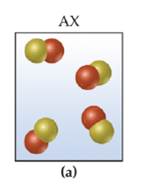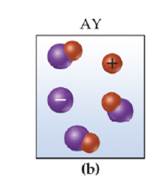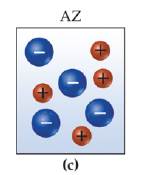
Chemistry: The Central Science (14th Edition)
14th Edition
ISBN: 9780134414232
Author: Theodore E. Brown, H. Eugene LeMay, Bruce E. Bursten, Catherine Murphy, Patrick Woodward, Matthew E. Stoltzfus
Publisher: PEARSON
expand_more
expand_more
format_list_bulleted
Textbook Question
Chapter 4, Problem 2E
Aqueous solutions of three different substances, AX, AY, and AZ, are represented by the three accompanying diagrams. Identify each substance as a strong electrolyte, a weak electrolyte, or a nonelectrolyte [Section 4.1 ]



Expert Solution & Answer
Want to see the full answer?
Check out a sample textbook solution
Students have asked these similar questions
Indicate the variation in conductivity with concentration in solutions of strong electrolytes and weak electrolytes.
The molar conductivity of a very dilute solution of NaCl has been determined. If it is diluted to one-fourth of the initial concentration, qualitatively explain how the molar conductivity of the new solution will compare with the first.
What does the phrase mean, if instead of 1 Faraday of electricity, Q coulombs (Q/F Faradays) pass through?
Chapter 4 Solutions
Chemistry: The Central Science (14th Edition)
Ch. 4.1 - If you have an aqueous solution that contains 1.5...Ch. 4.1 - If you were to draw diagrams representing aqueous...Ch. 4.2 - Prob. 4.2.1PECh. 4.2 - Classify the following compounds as soluble or...Ch. 4.2 - Yes or No: Will a precipitate form when solutions...Ch. 4.2 - a. What compound precipitates when aqueous...Ch. 4.2 - What happens when you mix an aqueous solution of...Ch. 4.2 -
Write the net ionic equation for the...Ch. 4.3 - Prob. 4.5.1PECh. 4.3 -
Imagine a diagram showing 10 Na + ions and 10 OH-...
Ch. 4.3 -
Which of these substances, when dissolved in...Ch. 4.3 - Consider solutions in which 0.1 mol of each of the...Ch. 4.3 -
Which is the correct ionic equation for the...Ch. 4.3 - For the reaction of phosphorous acid (H3PO3) and...Ch. 4.4 - Prob. 4.8.1PECh. 4.4 - What is the oxidation state of the boldfaced...Ch. 4.4 - Which of the following statements is true about...Ch. 4.4 - Prob. 4.9.2PECh. 4.4 - Which of these metals is the easiest to oxidize?...Ch. 4.4 - Which of the following metals will be oxidized by...Ch. 4.5 - Prob. 4.11.1PECh. 4.5 - Calculate the molarity of a solution made by...Ch. 4.5 - Prob. 4.12.1PECh. 4.5 - What is the molar concentration of K+ions in a...Ch. 4.5 - Prob. 4.13.1PECh. 4.5 -
How many grams of Na2SO4 are there in 15 mL of...Ch. 4.5 - Prob. 4.14.1PECh. 4.5 - What volume of 2.50 M lead(II) nitrate solution...Ch. 4.6 - How many milligrams of sodium sulfide are needed...Ch. 4.6 -
How many grams of NaOH are needed to neutralize...Ch. 4.6 - Prob. 4.16.1PECh. 4.6 - Prob. 4.16.2PECh. 4.6 - Practice Exercise 1 A mysterious white powder is...Ch. 4.6 - Prob. 4.17.2PECh. 4 - Prob. 1DECh. 4 - Prob. 1ECh. 4 - Aqueous solutions of three different substances,...Ch. 4 -
4 3 Use the molecular representations shown here...Ch. 4 - The concept of chemical equilibrium is very...Ch. 4 -
4 5 You are presented with a white solid and told...Ch. 4 - Which of the following ions will always be a...Ch. 4 - The labels have fallen off three bottles...Ch. 4 - Explain how a redox reaction involves electrons in...Ch. 4 - Prob. 9ECh. 4 - Prob. 10ECh. 4 -
4.11 Which data set, of the two graphed here,...Ch. 4 - You are titrating an acidic solution with a basic...Ch. 4 - State whether each of the following statements is...Ch. 4 - State whether each of the following statements is...Ch. 4 -
4.15 We have learned in this chapter that many...Ch. 4 - Prob. 16ECh. 4 -
4.17 Specify what ions are present in solution...Ch. 4 - Prob. 18ECh. 4 - Prob. 19ECh. 4 - Acetone. CH3COCH3, is a nonelectrolyte;...Ch. 4 -
4.21 Using solubility guidelines, predict whether...Ch. 4 - Prob. 22ECh. 4 - Prob. 23ECh. 4 - Prob. 24ECh. 4 - Which ions remain in solution, unreacted, after...Ch. 4 - Write balanced net ionic equations for the...Ch. 4 -
4.27 Separate samples of a solution of an unknown...Ch. 4 - Prob. 28ECh. 4 - Prob. 29ECh. 4 - Prob. 30ECh. 4 - Prob. 31ECh. 4 - Prob. 32ECh. 4 - State whether each of the following statements is...Ch. 4 - State whether each of the following statements is...Ch. 4 -
4.35 Label each of the following substances as an...Ch. 4 - An aqueous solution of an unknown solute is tested...Ch. 4 - Prob. 37ECh. 4 - Classify each of the following aqueous solutions...Ch. 4 - Complete and balance the following molecular...Ch. 4 - Write the balanced molecular and net ionic...Ch. 4 - Write balanced molecular and net ionic equations...Ch. 4 -
4.42 Because the oxide ion is basic, metal oxides...Ch. 4 -
4.43 Magnesium carbonate, magnesium oxide, and...Ch. 4 -
4.44 As K20 dissolves in water, the oxide ion...Ch. 4 - True or false: If a substance is oxidized, it is...Ch. 4 - Prob. 46ECh. 4 - Which region of the periodic table shown here...Ch. 4 - Determine the oxidation number of sulfur in each...Ch. 4 - Determine the oxidation number for the indicated...Ch. 4 - Determine the oxidation number for the indicated...Ch. 4 - Which element is oxidized, and which is reduced in...Ch. 4 - Which of the following are redox reactions? For...Ch. 4 -
4.53 Write balanced molecular and net ionic...Ch. 4 - Write balanced molecular and net ionic equations...Ch. 4 - Using the activity series (Table 4.5), write...Ch. 4 - Using the activity series (Table 4.5), write...Ch. 4 - The metal cadmium tends to form Cd2+ ions. The...Ch. 4 -
4.58 The following reactions (note that the...Ch. 4 - Is the concentration of a solution an intensive or...Ch. 4 - Prob. 60ECh. 4 - Calculate the molarity of a solution that contains...Ch. 4 -
4.62
Calculate the molarity of a solution made by...Ch. 4 - Prob. 63ECh. 4 - Prob. 64ECh. 4 - Prob. 65ECh. 4 -
4.66 The average adult male has a total blood...Ch. 4 -
4.67
How many grams of ethanol, CH2CH2OH should...Ch. 4 - Prob. 68ECh. 4 - Which will have the highest concentration of...Ch. 4 - Prob. 70ECh. 4 - Prob. 71ECh. 4 - Prob. 72ECh. 4 - Prob. 73ECh. 4 - Prob. 74ECh. 4 - Prob. 75ECh. 4 - Prob. 76ECh. 4 - Prob. 77ECh. 4 - Prob. 78ECh. 4 - Prob. 79ECh. 4 - Prob. 80ECh. 4 - Prob. 81ECh. 4 - Prob. 82ECh. 4 - Some sulfuric acid is spilled on a lab bench You...Ch. 4 -
4.84 The distinctive odor of vinegar is due to...Ch. 4 - A 4.36-g sample of an unknown alkali metal...Ch. 4 -
4.86 An 8.65-g sample of an unknown group 2A...Ch. 4 - A solution of 100.0 mL of 0.200 M KOH is mixed...Ch. 4 -
4.88 A solution is made by mixing 15.0 g of...Ch. 4 - Prob. 89ECh. 4 - A 1.248-9 sample of limestone rock is pulverized...Ch. 4 - 4.91 Uranium hexafluoride, UF6, is processed to...Ch. 4 - The accompanying photo shows the reaction between...Ch. 4 - Prob. 93AECh. 4 -
4.94 You choose to investigate some of the...Ch. 4 -
4 95 Antacids are often used to relieve pain and...Ch. 4 -
4 96 The commercial production of nitric acid...Ch. 4 - Consider the following reagents: zinc, copper,...Ch. 4 - 98 Bronze is a solid solution of Cu(s) and Sn(s);...Ch. 4 - Prob. 99AECh. 4 - Prob. 100AECh. 4 -
4.101 Hard water contains Ca2+ , Mg2 + , and Fe2+...Ch. 4 - Tartaric acid. H2C4H4O6, has two acidic hydrogens....Ch. 4 - Prob. 103AECh. 4 - A solid sample of Zn(OH)2 is added to 0.350 L of...Ch. 4 - Prob. 105IECh. 4 - Prob. 106IECh. 4 - Prob. 107IECh. 4 - A fertilizer railroad car carrying 34,300 gallons...Ch. 4 - Prob. 109IECh. 4 - Prob. 110IECh. 4 - Prob. 111IECh. 4 - Prob. 112IECh. 4 - Prob. 113IECh. 4 - Prob. 114IECh. 4 -
4.115 Federal regulations set an upper limit of...
Knowledge Booster
Learn more about
Need a deep-dive on the concept behind this application? Look no further. Learn more about this topic, chemistry and related others by exploring similar questions and additional content below.Similar questions
- What characteristics should an interface that forms an electrode have?arrow_forwardFor a weak acid AcH, calculate the dissociated fraction (alpha), if its concentration is 1.540 mol L-1 and the concentration [H+] is 5.01x10-4 mol L-1.arrow_forwardIf the molar conductivity at infinite dilution of HAC is A0 = 390.5 S cm² mol¹. Calculate the Arrhenius conductivity of a 9.3% by weight solution of HAc with a pH of 3.3. Data: molecular weight of HAC is 60.05 g/mol and the density of the solution is 1 g/cm³.arrow_forward
- If the molar conductivity at infinite dilution of HAC is A0 = 390.5 S cm² mol¹. Calculate the Arrhenius conductivity of a 9.3% by weight solution of HAc with a pH of 3.3. Data: molecular weight of HAC is 60.05 g/mol and the density of the solution is 1 g/cm³.arrow_forwardIf the molar conductivity at infinite dilution of HAC is A0 = 390.5 S cm² mol¹. Calculate the Arrhenius conductivity of a 9.3% by weight solution of HAc with a pH of 3.3. Data: molecular weight of HAC is 60.05 g/mol and the density of the solution is 1 g/cm³.arrow_forwardDetermine the distance between the metal and the OHP layer using the Helm- holtz model when the electrode's differential capacitance is 145 μF cm². DATA: dielectric constant of the medium for the interfacial zone &r= lectric constant of the vacuum &0 = 8.85-10-12 F m-1 = 50, die-arrow_forward
- Describe a sequence of photophysical processes that can be followed by radiation adsorbed by a molecule in the ground state to give rise to phosphorescent emission.arrow_forwardState two similarities between fluorescence and phosphorescence.arrow_forwardState three photophysical processes that can be related to the effects of incident radiation on a molecule in its ground state. Consider that radiation can give rise to fluorescent emission, but not phosphorescent emission.arrow_forward
arrow_back_ios
SEE MORE QUESTIONS
arrow_forward_ios
Recommended textbooks for you
 General Chemistry - Standalone book (MindTap Cour...ChemistryISBN:9781305580343Author:Steven D. Gammon, Ebbing, Darrell Ebbing, Steven D., Darrell; Gammon, Darrell Ebbing; Steven D. Gammon, Darrell D.; Gammon, Ebbing; Steven D. Gammon; DarrellPublisher:Cengage Learning
General Chemistry - Standalone book (MindTap Cour...ChemistryISBN:9781305580343Author:Steven D. Gammon, Ebbing, Darrell Ebbing, Steven D., Darrell; Gammon, Darrell Ebbing; Steven D. Gammon, Darrell D.; Gammon, Ebbing; Steven D. Gammon; DarrellPublisher:Cengage Learning Chemistry: Principles and ReactionsChemistryISBN:9781305079373Author:William L. Masterton, Cecile N. HurleyPublisher:Cengage Learning
Chemistry: Principles and ReactionsChemistryISBN:9781305079373Author:William L. Masterton, Cecile N. HurleyPublisher:Cengage Learning Chemistry for Engineering StudentsChemistryISBN:9781337398909Author:Lawrence S. Brown, Tom HolmePublisher:Cengage Learning
Chemistry for Engineering StudentsChemistryISBN:9781337398909Author:Lawrence S. Brown, Tom HolmePublisher:Cengage Learning ChemistryChemistryISBN:9781305957404Author:Steven S. Zumdahl, Susan A. Zumdahl, Donald J. DeCostePublisher:Cengage Learning
ChemistryChemistryISBN:9781305957404Author:Steven S. Zumdahl, Susan A. Zumdahl, Donald J. DeCostePublisher:Cengage Learning Chemistry: An Atoms First ApproachChemistryISBN:9781305079243Author:Steven S. Zumdahl, Susan A. ZumdahlPublisher:Cengage Learning
Chemistry: An Atoms First ApproachChemistryISBN:9781305079243Author:Steven S. Zumdahl, Susan A. ZumdahlPublisher:Cengage Learning

General Chemistry - Standalone book (MindTap Cour...
Chemistry
ISBN:9781305580343
Author:Steven D. Gammon, Ebbing, Darrell Ebbing, Steven D., Darrell; Gammon, Darrell Ebbing; Steven D. Gammon, Darrell D.; Gammon, Ebbing; Steven D. Gammon; Darrell
Publisher:Cengage Learning

Chemistry: Principles and Reactions
Chemistry
ISBN:9781305079373
Author:William L. Masterton, Cecile N. Hurley
Publisher:Cengage Learning

Chemistry for Engineering Students
Chemistry
ISBN:9781337398909
Author:Lawrence S. Brown, Tom Holme
Publisher:Cengage Learning

Chemistry
Chemistry
ISBN:9781305957404
Author:Steven S. Zumdahl, Susan A. Zumdahl, Donald J. DeCoste
Publisher:Cengage Learning

Chemistry: An Atoms First Approach
Chemistry
ISBN:9781305079243
Author:Steven S. Zumdahl, Susan A. Zumdahl
Publisher:Cengage Learning

Thermogravimetric Analysis [ TGA ] # Thermal Analysis # Analytical Chemistry Part-11# CSIR NET/GATE; Author: Priyanka Jain;https://www.youtube.com/watch?v=p1K-Jpzylso;License: Standard YouTube License, CC-BY